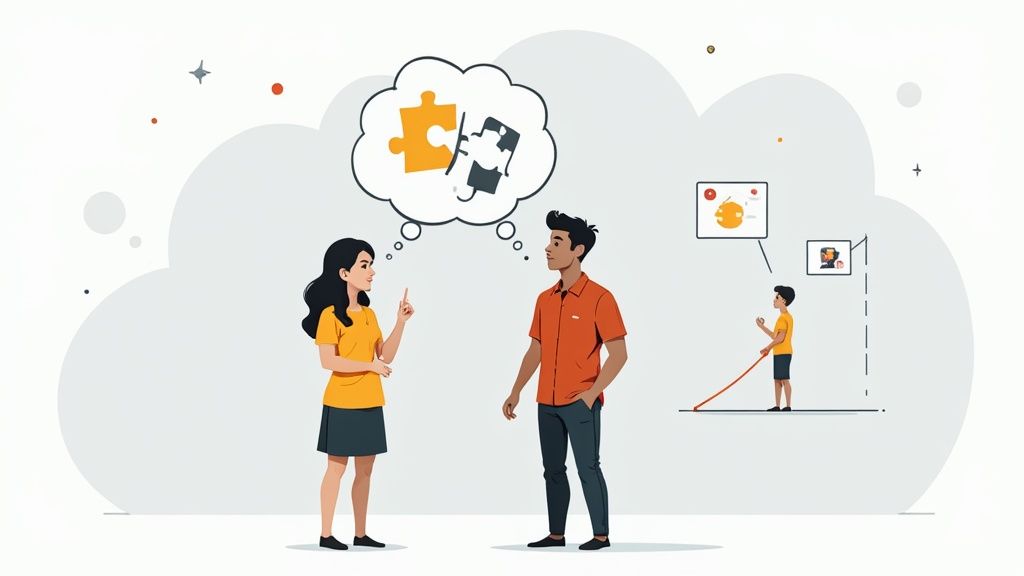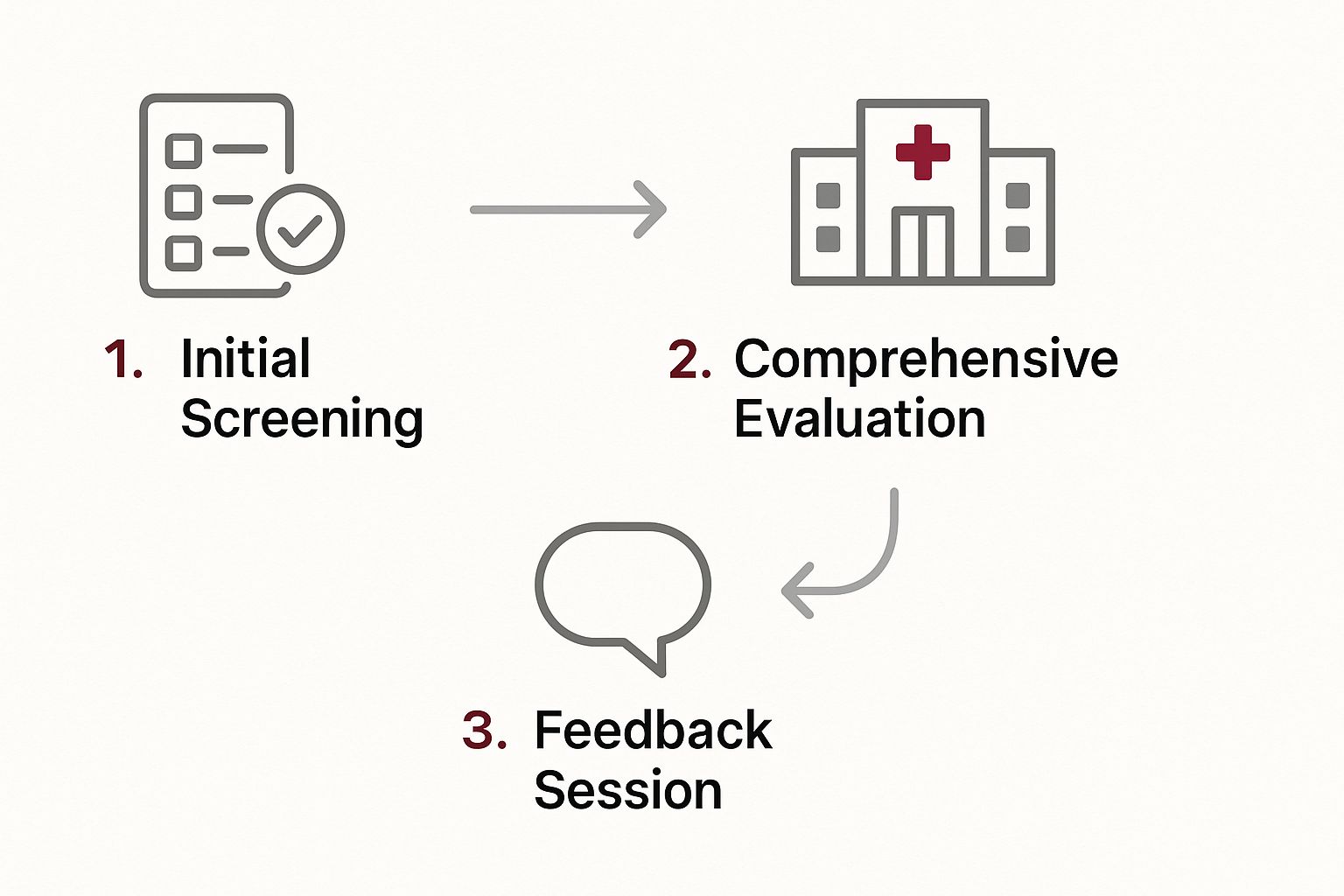The journey toward an autism assessment rarely starts with a single, dramatic event. More often, it's a slow-building awareness—a collection of small moments and observations that suggest things might be different.
Whether you're a parent noticing your child's unique way of interacting with the world or an adult who has always felt a bit out of sync, paying attention to these first signs is the crucial starting point.
Recognizing the First Signs and Preparing for the Conversation

This initial phase isn't about building a "case" or jumping to conclusions. Think of it as gathering information. Your goal is to paint a clear, detailed picture for a healthcare professional so they can guide you toward the right next steps.
A well-prepared conversation with a doctor feels much more productive and far less overwhelming.
How to Organize Your Observations
Before you even think about scheduling an appointment, take some time to jot down specific examples of what you've noticed. Vague descriptions like "he's socially awkward" aren't nearly as helpful as concrete examples.
For instance, "He doesn't seem to notice when his friends are upset and continues talking about his favorite topic" provides much more valuable insight for a clinician.
This preliminary information is what kicks off the entire process, often leading to a developmental screening and then a full diagnostic evaluation. For children, primary care providers might use brief checklists during regular check-ups, especially around 18 to 24 months old. If those results suggest potential autism, a referral to a specialist is the next move.
Key Takeaway: Your detailed notes aren't for self-diagnosis. They are a powerful tool to help a medical professional understand your concerns and provide an accurate referral for evaluation.
A Framework for Documenting Your Observations
To help you organize your thoughts, I've put together a simple framework. This table can help you structure your observations before your first appointment.
Remember, autism presents differently in everyone. Traits can be incredibly subtle, especially in those who have learned to "mask" or camouflage their differences. For a deeper look at how this can manifest, you might find our guide on common autistic traits in women insightful.
A Framework for Documenting Your Observations
| Area of Observation | Examples in Children | Examples in Adults |
|---|---|---|
| Social Communication | Difficulty with back-and-forth conversation, avoids eye contact, or has trouble making friends. | Finds small talk exhausting, misinterprets sarcasm, or feels a need to "script" conversations. |
| Repetitive Behaviors | Lines up toys instead of playing, repeats phrases (echolalia), or engages in hand-flapping. | Adheres to rigid daily routines, has intense, focused interests, or fidgets constantly (stimming). |
| Sensory Sensitivities | Overly sensitive to loud noises or certain textures, or seems under-reactive to pain. | Feels overwhelmed by bright lights or strong smells, or seeks out specific sensory inputs. |
Using a structure like this can make your notes more focused and ensures you cover the key areas a specialist will want to know about. It transforms your gut feelings into actionable information.
Finding a Specialist Who Understands Autism
Securing an assessment from the right professional is easily one of the most critical steps in the entire journey. The kind of specialist you'll need really depends on the age of the person being evaluated.
For children, your search will likely lead you to a developmental pediatrician, a child psychologist, or a pediatric neuropsychologist. These experts live and breathe childhood development and are trained to spot how autism presents in kids.
For adults, the path usually points toward a clinical psychologist or a neuropsychologist who specifically focuses on adult autism. This is so important. An expert in adult diagnosis knows how to recognize traits that may have been "masked" or unknowingly suppressed for years, sometimes decades.
Where to Find Qualified Professionals
So, where do you even start? It can feel like a huge task, but there are a few straightforward ways to find a qualified diagnostician.
Your first and often best move is to talk to your primary care provider or your child's pediatrician. They usually have a network of trusted specialists they can refer you to, which can save a lot of legwork.
Another great option is to check your health insurance provider’s online directory. You can usually filter by specialty, like "psychology" or "neuropsychology," and by location. From there, you can build a list of names to start researching.
Don't overlook local and national autism organizations. Groups like the Autistic Self Advocacy Network (ASAN) or regional autism societies often keep lists of recommended providers who are known for being respectful, knowledgeable, and up-to-date.
It's a hard truth, but not all clinicians have the same level of experience, especially with presentations that don't fit the old stereotypes. For instance, research suggests that up to 80% of autistic women are still undiagnosed by the time they reach adulthood, largely due to outdated diagnostic biases. Finding a specialist who gets this is absolutely key.
Questions to Ask a Potential Diagnostician
Once you have a list of potential providers, it's a good idea to have a quick chat on the phone or send an email. Think of it as a pre-screening. This is your chance to get a feel for their approach and make sure they’re the right fit before you commit to a full evaluation.
Here are a few questions you might want to ask to gauge their expertise:
- Experience with Your Age Group: "What percentage of your practice is dedicated to evaluating adults (or children) for autism?"
- Understanding of Nuance: "How do you approach diagnosing autism in people who might be masking their traits, like women or high-achieving professionals?"
- The Diagnostic Process: "Could you give me a brief rundown of your evaluation process? What specific tools or methods do you use?"
- Telehealth Options: "Do you offer any assessments virtually or through telehealth?"
Asking these kinds of direct questions helps you find someone with not just the right credentials, but also the modern, nuanced understanding needed for an accurate and validating diagnosis. It’s a proactive step that can make all the difference.
What Really Happens During an Autism Evaluation
The thought of a formal evaluation can feel pretty daunting. I find that pulling back the curtain on what these sessions actually involve—the real, step-by-step process—can significantly reduce that anxiety and help you feel much more prepared.
It's not a single, simple "autism test." A comprehensive evaluation is a much bigger picture, designed to gather information from different angles to build a complete understanding of a person's developmental history, social communication style, and behavioral patterns.
This graphic gives a great overview of the typical flow, from that first screening all the way to the final feedback session.
As you can see, the whole process is structured to be thorough. It ensures a careful and thoughtful assessment before any conclusions are drawn.
The Core Components of an Evaluation
Most diagnostic evaluations, whether for a child or an adult, will blend interviews, direct observation, and standardized questionnaires. Each piece of the puzzle serves a specific purpose in helping the clinician understand the whole person.
You can generally expect these key elements:
- Clinical Interviews: This is really just a detailed conversation with the clinician. They’ll ask about everything from early childhood development and social relationships to current challenges and personal strengths. For a child's evaluation, parents are the ones who provide most of this history.
- Self-Reports and Questionnaires: You'll likely fill out several forms. These might include tools like the Autism Spectrum Quotient (AQ), which helps quantify traits commonly associated with autism.
- Behavioral Observations: The clinician will observe how you or your child communicates and interacts. This isn’t a performance test to be nervous about; it’s simply a way to see social and communication styles in a natural or semi-structured setting.
Demystifying the Diagnostic Tools
Clinicians often use "gold standard" assessment tools to guide their observations. You might hear them mention the ADOS-2 or the ADI-R. It's important to remember these are not pass/fail tests, but structured frameworks for gathering information.
The ADOS-2 (Autism Diagnostic Observation Schedule, Second Edition) involves a series of semi-structured activities and conversations. For a kid, this might look like playing with specific toys to see how they engage in social back-and-forth. For an adult, it could involve looking at a picture book and telling a story or just chatting about daily life.
The whole point of these activities is to create natural opportunities for social communication. This allows the professional to observe things like eye contact, shared enjoyment, and how a person responds to social cues.
The ADI-R (Autism Diagnostic Interview-Revised), on the other hand, is a very detailed interview conducted with a parent or caregiver. It provides a deep dive into the person's entire developmental history, which is absolutely crucial for making an accurate diagnosis.
Virtual vs. In-Person Assessments
Technology has made a huge difference in how people get tested for autism. Many providers, including us, now offer evaluations through telehealth. This can be a fantastic option for reducing the stress and logistical headaches of in-person visits, allowing the assessment to happen in a familiar, comfortable environment.
If you're curious about this, you can learn more about the specifics of a telehealth autism diagnosis and how it works.
Whether you choose a virtual or in-person assessment, the core components remain the same. The goal is always to gather enough high-quality information to make an accurate and thoughtful determination, moving you one step closer to clarity and the right support.
Navigating Costs, Insurance, and Waitlists
Let’s talk about the practical side of getting an autism evaluation—the money, the insurance headaches, and the waiting. For many families, this is the biggest hurdle. Knowing what to expect financially and logistically from the start can make a world of difference.
A full, private evaluation doesn't come cheap. You can expect to see prices ranging anywhere from $1,500 to over $5,000. That number reflects a specialist's dedicated time for in-depth interviews, direct testing, scoring the results, and crafting a comprehensive report.
This significant cost is a major reason why getting an autism diagnosis and the right support can be so difficult. It's a global issue. In the U.S. alone, reports show that 1 in 9 children with autism don't get the healthcare they need, a gap often driven by high costs and a lack of accessible providers. You can dig deeper into these kinds of statistics in the 2025 Autism by the Numbers Annual Report.
Working with Your Health Insurance
Your health insurance might cover some of the cost, but you'll need to be persistent to make it happen. Before you even think about booking an appointment, get on the phone with your insurance company, ready with a list of very specific questions.
Your first question should always be for a list of in-network psychologists or neuropsychologists who are qualified to conduct autism evaluations. Sticking with an in-network provider is your best bet for keeping costs manageable.
Once you have that list, you need to get into the nitty-gritty of your coverage. Don't hang up until you have clear answers to these questions:
- "Do I need pre-authorization for a diagnostic autism evaluation?"
- "What is my deductible, and how much is left for this year?"
- "Once my deductible is met, what percentage of the cost will insurance cover for an in-network provider?"
- "Are there any limits on the number of testing hours that are covered?"
Having these answers upfront helps you budget realistically and prevents those awful surprise bills down the road.
Key Takeaway: Never end a call with your insurance company without getting a pre-authorization number or a reference code for the conversation. This little piece of information is your best defense if you have to fight a denied claim later on.
Finding More Accessible Evaluation Pathways
If the cost of a private evaluation is just too high, don't lose hope. There are other routes you can take. They might take longer, but they can dramatically ease the financial burden.
For parents of school-aged children, the public school system is a powerful resource. You have the right to request a free evaluation to see if your child qualifies for an Individualized Education Program (IEP) and other school-based supports. This won't give you a medical diagnosis, but it's an essential first step for securing accommodations in the classroom.
Another fantastic, often more affordable option, is to look into local universities. Many colleges with psychology or medical schools run training clinics. Here, graduate students perform evaluations under the close supervision of licensed professionals, usually for a much lower fee than private practices.
Finally, you have to prepare for the wait. The hard truth is that there are far more people seeking evaluations than there are qualified diagnosticians. This supply-and-demand problem creates waitlists that can easily stretch from a few months to more than a year. It's often a smart move to get your name on a few different lists while you explore all your options.
From Diagnosis to Direction: What Comes Next
Getting the results from an autism evaluation is a huge moment. Whether it's for you or your child, that detailed report you're holding is so much more than a clinical summary—it’s a practical roadmap for the future.
This document is the culmination of weeks of observation and testing, all translated into real-world, actionable insights. The first step is just getting comfortable with its structure and language so you can start putting it to good use.
How to Read Your Diagnostic Report
At first glance, a comprehensive diagnostic report can look pretty dense. It’s often filled with clinical terms and test scores that might feel overwhelming. Don't let it intimidate you. It’s built to be thorough, telling a complete story through several distinct sections.
You’ll almost always see these key areas:
- Background and Developmental History: This part is a recap of the information you shared in interviews. It outlines key developmental milestones and any challenges noted over time.
- Assessment Tools and Procedures: This is a simple list of the specific tests that were administered, like the ADOS-2, along with any questionnaires used.
- Behavioral Observations: Here, the clinician shares what they saw firsthand—notes on communication style, social interactions, and other behaviors observed during the evaluation.
- Diagnostic Impressions: This is the clinical conclusion. It’s where the report will state whether the criteria for Autism Spectrum Disorder (or other conditions) were officially met.
- Recommendations: This is arguably the most important section for figuring out what to do next.
Key Insight: Your diagnostic report is a legal document. It acts as official proof of diagnosis, which is essential for accessing many formal supports, from therapies covered by insurance to workplace accommodations under the Americans with Disabilities Act (ADA).
Translating Recommendations into Action
The recommendations section is your personal guide. It’s where the clinical findings get connected to actual, real-world support systems. Think of it as a personalized plan to help you or your child thrive.
For a child, these recommendations will likely point toward specific therapies, such as:
- Speech Therapy: To help with expressive, receptive, and social language skills.
- Occupational Therapy: To work on sensory processing needs and skills for daily living.
- Social Skills Groups: To provide a safe, guided space to practice social interaction.
This section of the report is also your ticket to unlocking school-based supports. You can bring it to the school when requesting an Individualized Education Program (IEP) or a 504 plan. These legally require the school to provide accommodations like extra time on tests or access to a quiet space for breaks.
For adults, the recommendations might lean more toward things like workplace accommodations. This could mean asking for instructions in writing instead of verbally, using noise-canceling headphones to manage sensory input, or arranging for a more flexible work schedule.
A Diagnosis Is a Gateway, Not a Label
It's completely normal to feel a whole mix of emotions after a diagnosis. For many people, the most powerful feeling is relief—it’s a validation of a lifetime of experiences and a brand-new lens for understanding yourself.
An autism diagnosis isn't an endpoint. It’s a powerful tool for self-advocacy, a key that unlocks tailored support, and an open invitation to connect with a neurodivergent community that just gets it. It gives you a shared language and a solid framework for building a life that honors your most authentic self.
To get more prepared for this new chapter, you can find some fantastic guidance on what to expect after an autism diagnosis. This is your chance to finally move forward with confidence and clarity.
Common Questions About the Autism Testing Process
As you start looking into how to get tested for autism, you're bound to have questions. It can feel like a complicated world to step into, but getting clear, direct answers can make the whole journey feel much more straightforward.
Let's walk through some of the questions we hear most often.
How Long Does the Autism Testing Process Usually Take?
This is the big question for most people, and the honest answer is: it varies a lot. Once you have a referral from your primary doctor, just getting an appointment with a specialist can take anywhere from a few months to over a year. That wait is often the longest part of the entire process.
The evaluation itself might be done in one long day or broken up into several shorter appointments over a few weeks. After the last assessment, the clinician needs time to score everything, interpret the results, and write up a detailed report. That final step usually takes another two to four weeks.
Realistically, you should expect the entire process—from that first referral to holding the final report in your hands—to take at least three to six months. In many places, it can easily stretch beyond a year depending on your location and the availability of qualified providers.
Is It Possible to Get Tested for Autism as an Adult?
Yes, absolutely. We're seeing more and more adults seeking an autism diagnosis as public awareness grows. The process for adults is different from a child's evaluation; it focuses heavily on in-depth interviews about your entire life, from your earliest memories to your current experiences at work or in relationships.
It's really important to find a professional who specializes in adult diagnosis. They know how to see past the sophisticated coping strategies—often called masking—that many autistic adults have developed over a lifetime. For so many people, finally getting that diagnosis as an adult brings a profound sense of relief and validation. It's the "aha" moment that connects the dots of their entire life experience.
What Is the Difference Between a School Evaluation and a Medical Diagnosis?
This is a critical distinction that can cause a lot of confusion.
A school evaluation is done by the public school system for one specific reason: to see if a student qualifies for special education services. The outcome is an educational classification (like "Autism"), not a medical diagnosis. Its purpose is purely academic.
A medical diagnosis, however, is a clinical finding from a healthcare professional, like a psychologist or developmental pediatrician. This is the official diagnosis you need to access things like:
- Insurance-funded therapies (like speech or OT)
- Other medical services
- Workplace accommodations under the ADA
While a school evaluation is essential for getting an IEP or 504 plan, the medical diagnosis is what opens the door to support outside of the school system.
At the Sachs Center, our psychologists are experts in diagnosing autism and ADHD, especially in individuals who have become skilled at masking. We offer telehealth evaluations from the comfort of your home, which helps reduce stress and provides clear, actionable answers. If you are ready to gain clarity on your journey, book your evaluation at sachscenter.com.


